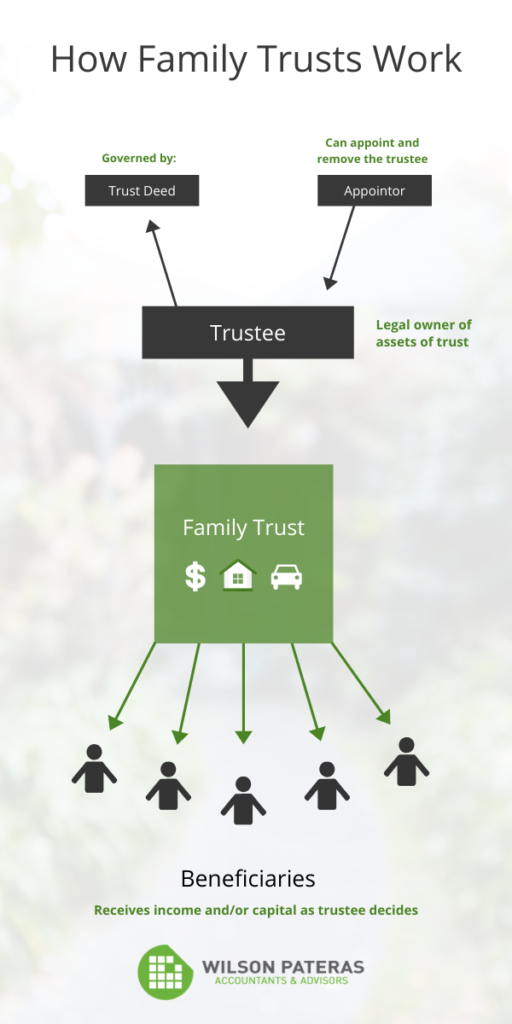
What is a family trust?
A family trust is a common type of trust used to hold assets or run a family business.
Essentially, it is a relationship where a trustee holds property or assets for the benefit of a beneficiary or beneficiaries.
Trusts can benefit anyone who wants to manage their money in a way that is more tax effective and beneficial to their family.
In this article we take a closer look at family trusts, how they work, trust benefits and advantages, so that you can be informed about what the best structure is for your business.
Setting up a family trust is often driven by a new business opportunity, a growing business, or a need to better structure your investments. When set up correctly, there are clear tax benefits when it comes to operating as a family trust.
How do family trusts work?
Family trusts work in a similar way to a parent opening a bank account for a child. While that account and the money within belong to the child, the parent is the person responsible for and ultimately in control of the account.

The trust
The trust is the relationship or structure between trustees and beneficiaries. You could think of a trust as a container of sorts, that things are placed within. All assets placed into the container become property of the trust, controlled by the trustee for the sake of the beneficiary.
The Trustee
The trustee can be an individual, individuals or a company and they are the legal entity who owns the assets and makes decisions on the trust’s behalf. There can be more than one trustee and more than one beneficiary. In most cases, the trustees are usually parents or a company that they own, and the beneficiaries are their children or dependants.
The trustee owns and controls the business’ assets, distributes income and must comply with the obligations of the trust deed and act with the best interests of the beneficiaries in mind.
The trustee is also responsible for registering the trust for tax purposes, lodging tax returns and meeting any other tax obligations on behalf of the trust.
Beneficiaries
The beneficiaries are the people entitled to the income and assets of the trust.
The beneficiaries of the trust are usually members of a family (family group), as well as companies and trusts that are controlled by that family.
For example, the primary or default beneficiaries may be a parent or parents and the secondary beneficiaries maybe children, grandparents, companies etc.
The role of the default beneficiary is to receive and/or decide the direction of any funds that aren’t allocated by the trustee. It’s also important to note that you cannot change the default beneficiary without triggering capital gains tax and stamp duty.
Beneficiaries will generally include their share of the trust’s net income as income in their own tax returns and if they receive income from other sources they will be taxed for these as well.

Family trusts: benefits
Asset Protection
Many business owners face a degree of risk in owning a business, for example if the business fails, they may be sued personally or put at risk of bankruptcy. Similarly, those in partnerships, particularly those with bank debts, can face similar risks.
Assets that are within a family trust are protected from creditors, so even if a claim is made against you, the assets are not in your name and therefore cannot be accessed in these circumstances.
Tax Advantages
Operating your business from a family trust and having the company act as trustee means you can retain the limited liability benefits of a company structure while taking advantage of the tax flexibility benefits of a family trust.
We dig deeper into the tax benefits of family trusts below.
Keeping it in the Family
Whether you’re looking to keep your family home in the family or want to stagger inheritance distribution to ensure it’s not all spent at once, a family trust prevents Will contests and secures assets.
Assets held within the trust do not form part of a deceased estate preventing contests to a Will or your child’s spouse claiming their share of an inheritance.
A family trust can provide long term financial support for your children or grandchildren, allowing you to invest in their long-term education and distribute family assets to future generations.
A family trust can also be a great way to protect vulnerable beneficiaries who may make poor spending decisions if they were to control their own assets.

Family trusts: disadvantages
The Small Print
Any income earned by the trust that is not distributed is taxed at the highest marginal tax rate.
If you do find you are making a lot of profit as a family trust, those profits have to be pushed out to beneficiaries. You could run out of beneficiaries and those beneficiaries will be paying highest tax rate.
With a family trust, you can add additional beneficiaries if the trust deed allows for it, but care must be taken as capital gains tax and stamp duty may be triggered if done incorrectly.
The trust cannot allocate tax losses to beneficiaries either.
Family Matters
Despite preventing some disputes within the family, there can be challenges in running the trust when other family issues occur.
There can also be some complexities regarding succession planning and asset allocation upon the death of the trustee.
With a Will, you can dictate what goes to who, however, a family trust is separate to an individual’s will and you may be able to choose who controls the trust, you don’t dictate how they control it.
Maintenance
A family trust requires on-going accounting and tax advice throughout its life. These costs are generally around the $2000 mark, for very simple holding trusts. However, this figure is likely to increase as the trust becomes more complex.

Family trusts and tax returns
When set up correctly, there are clear family trust tax benefits for individuals and businesses.
Because the trust itself does not pay tax, beneficiaries are taxed based on the amount of income placed in their name (as well as any other income they may have from other sources).
A family trust allows you to distribute profit amongst family members to utilise their income tax “tax-free thresholds”.
If the business’ profits grow too large to distribute effectively, a family trust can also distribute to a separate company to cap the tax rate at 27.5 per cent.
Family Trust vs Company
One of the key differences between a trustee company and a trading company, is that the trustee company doesn’t trade, it doesn’t have its own tax file number and it doesn’t lodge a tax return of its own. It simply makes decisions for and on behalf of the family trust.
Some other important distinctions are:
- Companies cannot access the 50% capital gains discount, whereas a family trust can. Small business capital gains tax discounts can be accessed by both.
- A company is paying tax at 30% or 27.5% and pays tax from the first dollar. However, a family trust doesn’t pay tax and profits are pushed out each year.
- A company can accumulate profits and reinvest those profits into the business as working capital.
- Companies are great for doing business with unrelated parties and you will be protected by the Corporations Act. As for a trust, if a party is not within family group, you cannot bring them into the trust with you.
Is a family trust right for my business?
While the family trust tax and asset protection benefits are obvious, there is a lot to consider and a lot at stake.
Entering into a family trust isn’t a simple decision and requires careful consideration and planning for the future of your business and/or investments.
At Wilson Pateras, our expert accountants can help you determine whether a family trust is right for you and your business.
This article contains general advice only. It does not take into account your or your family’s individual objectives, financial situation or needs. You should seek advice from a financial planner or other professional adviser before making any financial decision based on this information.




